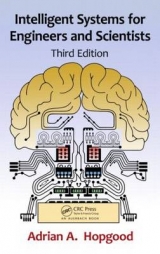
Intelligent Systems for Engineers and Scientists, Second Edition
Crc Press Inc (Verlag)
978-0-8493-0456-9 (ISBN)
- Titel erscheint in neuer Auflage
- Artikel merken
This updated version of the best-selling Knowledge-Based Systems for Engineers and Scientists (CRC Press, 1993) embraces both the explicit knowledge-based models retained from the first edition and the implicit numerical models represented by neural networks and optimization algorithms. The title change to Intelligent Systems for Engineers and Scientists reflects its broader scope, incorporating knowledge-based systems, computational intelligence, and their hybrids.
Clear and concise, the book shows the issues encountered in the development of applied systems and describes a wide range of intelligent systems techniques. The author describes each technique at the level of detail required to develop intelligent systems for real applications. Whether you are building intelligent systems or you simply want to know more about them, Intelligent Systems for Engineers and Scientists provides you with a detailed, up-to-date, and practical guide to solving real problems in science and engineering.
This indispensable book provides everything in one volume:
BREADTH - from knowledge-based systems to computational intelligence
DEPTH - from introductory concepts to advanced specialist techniques
SCOPE - from principles to practicalities
INTRODUCTION
Intelligent Systems
Knowledge-Based Systems
The Knowledge Base
Deduction, Abduction, and Induction
The Inference Engine
Declarative and Procedural Programming
Expert Systems
Knowledge Acquisition
Search
Computational Intelligence
Integration with other Software
RULE-BASED SYSTEMS
Rules and Facts
A Rule-Based System for Boiler Control
Rule Examination and Rule Firing
Maintaining Consistency
The Closed-World Assumption
Use of Variables within Rules
Forward-Chaining
Conflict Resolution
Backward-Chaining
A Hybrid Strategy
Explanation Facilities
DEALING WITH UNCERTAINTY
Sources of Uncertainty
Bayesian Updating
Certainty Theory
Fuzzy Logic
Other Techniques
OBJECT-ORIENTED SYSTEMS
Objects and Frames
An Illustrative Example
Introducing OOP
Data Abstraction
Inheritance
Encapsulation
Unified Modeling Language (UML)
Dynamic (or late) Binding
Message Passing and Function Calls
Type Checking
Further Aspects of OOP
Frame-Based Systems
INTELLIGENT AGENTS
Characteristics of an Intelligent Agent
Agents and Objects
Agent Architectures
Multiagent Systems
SYMBOLIC LEARNING
Introduction
Learning by Induction
Case-Based Reasoning
OPTIMIZATION ALGORITHMS
Optimization
The Search Space
Searching the Search Space
Hill-Climbing and Gradient Descent Algorithms
Simulated Annealing
Genetic Algorithms
NEURAL NETWORKS
Introduction
Neural Network Applications
Nodes and Interconnections
Single and Multilayer Perceptrons
The Hopfield Network
MAXNET
The Hamming Network
Adaptive Resonance Theory (ART) Networks
Kohonen Self-Organizing Networks
Radial Basis Function Networks
HYBRID SYSTEMS
Convergence of Techniques
Blackboard Systems
Genetic-Fuzzy Systems
Neuro-Fuzzy Systems
Genetic Neural Systems
Clarifying and Verifying Neural Networks
Learning Classifier Systems
TOOLS AND LANGUAGES
A Range of Intelligent Systems Tools
Expert System Shells
Toolkits and Libraries
Artificial Intelligence Languages
Lisp
Prolog
Comparison of AI Languages
SYSTEMS FOR INTERPRETATION AND DIAGNOSIS
Introduction
Deduction and Abduction for Diagnosis
Depth of Knowledge
Model-Based Reasoning
Case Study: A Blackboard System for Interpreting Ultrasonic Images
SYSTEMS FOR DESIGN AND SELECTION
The Design Process
Design as a Search Problem
Computer Aided Design
The Product Design Specification (PDS)
Conceptual Design
Constraint Propagation and Truth Maintenance
Case Study: The Design of a Lightweight Beam
Design as a Selection Exercise
Failure Mode and Effects Analysis (FMEA)
SYSTEMS FOR PLANNING
Introduction
Classical Planning Systems
STRIPS
Considering the Side Effects of Actions
Hierarchical Planning
Postponement of Commitment
Job-Shop Scheduling
Constraint-Based Analysis
Replanning and Reactive Planning
SYSTEMS FOR CONTROL
Introduction
Low-Level Control
Requirements of High-Level (Supervisory) Control
Blackboard Maintenance
Time-Constrained Reasoning
Fuzzy Control
The BOXES Controller
Neural Network Controllers
Statistical Process Control (SPC)
CONCLUDING REMARKS
Benefits
Information
Trends
INDEX
| Erscheint lt. Verlag | 11.10.2000 |
|---|---|
| Verlagsort | Bosa Roca |
| Sprache | englisch |
| Maße | 156 x 235 mm |
| Gewicht | 816 g |
| Themenwelt | Informatik ► Theorie / Studium ► Künstliche Intelligenz / Robotik |
| ISBN-10 | 0-8493-0456-3 / 0849304563 |
| ISBN-13 | 978-0-8493-0456-9 / 9780849304569 |
| Zustand | Neuware |
| Informationen gemäß Produktsicherheitsverordnung (GPSR) | |
| Haben Sie eine Frage zum Produkt? |
aus dem Bereich



